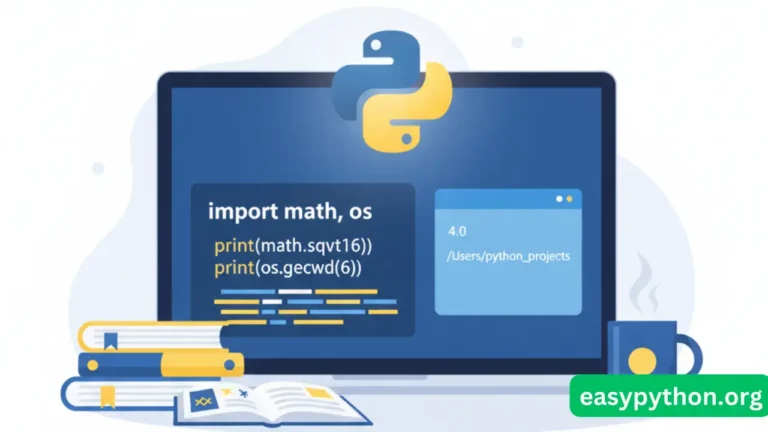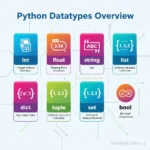Picture this: you buy a shiny new car 🚗. You sit inside, and there’s a steering wheel, AC, wipers, radio—all already built-in. You don’t go out and buy an extra “steering wheel” plugin from eBay, right?
Python works the same way. It comes with built-in modules and functions that make your coding life a lot easier. Yet, beginners often ignore them and start Googling “How to do X in Python” when the solution is literally baked into the language. 🍪
So buckle up—this is your cheat sheet to mastering Python’s built-in goodness (without pulling your hair out).
What Are Python Built-in Functions?
Think of built-in functions as Python’s “free tools” that come out of the box. No downloads. No pip install headaches.
Examples?
print()→ Your BFF for showing stuff on screen.len()→ The lazy coder’s ruler to measure string/list length.type()→ The “what are you?” detective.max()&min()→ The dramatic duo for biggest/smallest values.
👉 Want a smooth start with basics? Check out this Beginner’s Python Getting Started Guide.
Most Commonly Used Python Built-in Functions
Here are some you’ll use almost every day:
print()– Prints output (aka the “Hello World!” starter pack).print("Hello, EasyPython!")len()– Length of a string, list, or basically anything measurable.print(len("Python")) # Output: 6input()– Lets users type stuff. (Yes, the one teachers love in assignments).sum()– Adds numbers in a list faster than you can say “math class trauma.”abs()– Absolute value. Because -99 is still 99 when you’re broke. 💸sorted()– Orders your messy data. Kind of like Marie Kondo for lists.
👉 Bonus tip: Knowing variables is essential before playing with these. Read this quick guide on Python Variables & Assigning Values.
Python Built-in Modules You Can’t Ignore
Modules = “pre-packed toolkits” in Python. Instead of reinventing the wheel, you just import and roll.
math Module
For nerdy calculations beyond + - * /.
import math
print(math.sqrt(16)) # Output: 4.0
print(math.pi) # Output: 3.14159...datetime Module
Handles time & dates (because your computer doesn’t magically know it’s Friday).
from datetime import datetime
print(datetime.now())os Module
Lets you talk to your operating system—files, directories, environment variables.
random Module
For games, dice rolls, or making life less predictable. 🎲
👉 Quick plug: Don’t forget to understand Python Data Types first—your modules will thank you later.
Python Built-in Functions Table
| Function | Description | Example | Output |
|---|---|---|---|
print() | Prints output to the console | print("Hello") | Hello |
len() | Returns length of an object (string, list, etc.) | len("Python") | 6 |
type() | Returns the data type of a value | type(42) | <class 'int'> |
abs() | Returns absolute value | abs(-9) | 9 |
round() | Rounds a number to given decimals | round(3.14159, 2) | 3.14 |
sum() | Returns sum of items in iterable | sum([1,2,3]) | 6 |
max() | Returns largest value | max(4, 7, 2) | 7 |
min() | Returns smallest value | min(4, 7, 2) | 2 |
sorted() | Returns a sorted list | sorted([3,1,2]) | [1, 2, 3] |
input() | Takes input from user | name = input("Enter: ") | User enters text |
help() | Displays help/documentation for object | help(len) | Docs for len |
dir() | Returns list of attributes/methods of object | dir([]) | [... 'append'] |
id() | Returns unique identifier of object | id("x") | (memory addr) |
all() | Returns True if all items in iterable are True | all([1, True, 5]) | True |
any() | Returns True if at least one item in iterable is True | any([0, False, 7]) | True |
range() | Generates sequence of numbers | list(range(3)) | [0,1,2] |
enumerate() | Returns index + value pairs | list(enumerate(["a","b"])) | [(0,'a'),(1,'b')] |
map() | Applies a function to all items in iterable | list(map(str.upper, ["a","b"])) | ['A','B'] |
filter() | Filters items based on condition | list(filter(lambda x:x>2,[1,2,3])) | [3] |
zip() | Combines iterables element-wise | list(zip([1,2],[‘a’,‘b’])) | [(1,'a'),(2,'b')] |
Built-in Functions vs. User-defined Functions
Here’s where newbies get confused.
- Built-in: Already available, like
print(). - User-defined: You make them yourself, like:
def greet(name): return f"Hello, {name}!"
Think of it like this: built-ins are fast food 🍔, user-defined are your homemade recipes 👩🍳. Both have their place.
Funny Story: My First Encounter with len()
True story: In my first coding class, I counted characters in a string manually like an idiot. Teacher walked past, looked at me, and whispered:
“Son, Python has
len(). Stop being human.”
That day, I swore loyalty to built-in functions.
Pro Tips to Master Python Built-ins
- Don’t memorize all functions (there are 60+). Learn the top 20 you’ll use daily.
- Always try
help(function_name)in Python. It’s like Siri but less sassy. - Explore Python Collections (Lists, Tuples, Sets, Dicts)—many built-ins revolve around them.
- Use them in small projects: calculators, random number games, or file organizers.
FAQs About Python Built-in Functions and Modules
Q1. How many built-in functions does Python have?
Around 68 in Python 3.x (but no, you don’t need all of them at once).
Are Python built-in modules different from libraries?
Modules are single files, libraries are collections. Simple math.
What’s the best way to remember built-ins?
Use them in practice. Repetition > memorization.
Related Resources to Explore
- Official Python Documentation (the holy book 📖).
- W3Schools on Python Built-in Functions.
- And of course, our friendly Python IDLE Tutorial for practice.
Conclusion
If you’re ignoring built-in modules and functions, you’re like someone buying a smartphone but only using it as a flashlight. 🔦
Python gives you powerful tools right out of the box—use them, experiment, and laugh at your past self for reinventing the wheel.
So next time you code, remember: Why struggle, when Python has it built-in?





[…] 👉 Full list? Check out the Python built-in functions guide. […]
[…] 👉 Full deep dive here: Python Built-in Functions and Modules. […]